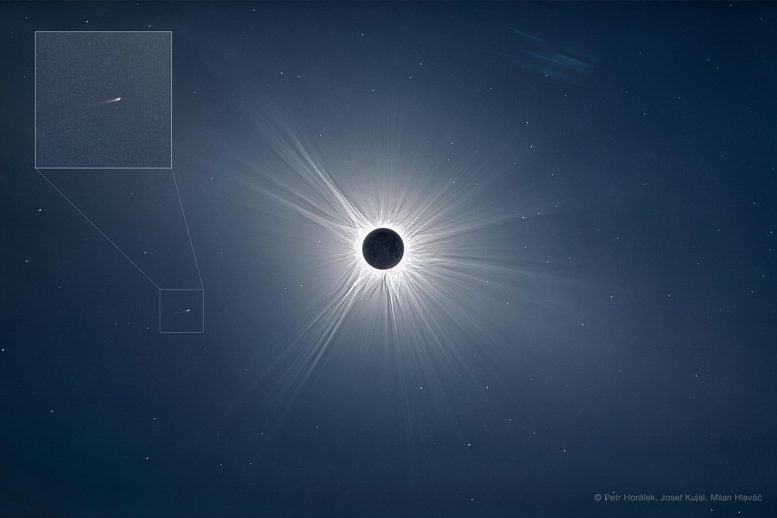
On April 8, 2024, Comet SOHO-5008 was seen and photographed during a solar eclipse before it quickly fell apart. Credit: Petr Horálek (Institute of Physics in Opava), Josef Kujal (Astronomy Society in Hradec Králové), Milan Hlaváč
Comet SOHO-5008 was found by a non-professional scientist and captured during a solar eclipse on April 8, 2024, before it broke up near the Sun, showing SOHO’s important role in identifying comets that pass close to the Sun.
Early on April 8, 2024, a non-professional scientist discovered a comet in images from the ESA/NASA Solar and Heliospheric Observatory (SOHO). It follows the recent discovery of SOHO’s 5000th comet. But this one – named Comet SOHO-5008 – was special for a different reason.
Karl Battams (US Naval Research Lab), manager of the SOHO Sungrazer Project, forecasted that comet SOHO-5008 would be visible during the total solar eclipse, which was due to plunge parts of the United States and Mexico into darkness later that very same day.
Petr Horálek, from the Institute of Physics in Opava (Czechia), was in Mexico for the eclipse. The clouds cleared and Petr could take this beautiful shot of the Sun’s awe-inspiring corona. To the lower left of the Sun, Comet SOHO-5008 is revealed.
Soon after Petr took the comet on camera, it met its end, coming so close to the Sun that it disintegrated.

Same image as above, with inset highlighting SOHO-5008. Credit: Petr Horálek (Institute of Physics in Opava), Josef Kujal (Astronomy Society in Hradec Králové), Milan Hlaváč
Observations of these ‘sungrazing’ comets from the ground are very rare, and this sighting was only possible thanks to the total solar eclipse.
The image is a combination of 100 frames, with the wide corona imaged at a focal length of 200 mm (exposure time from 1/4000 to 2 seconds) and the inner corona imaged at a focal length of 1100 mm (exposure time from 1/500 to 4 seconds).
SOHO’s ability to find comets was not planned, but turned out to be an unexpected success. With its clear view of the Sun’s surroundings, SOHO can easily discover comets that pass close to the Sun. This has made it the most successful discoverer of comets in astronomical history.



